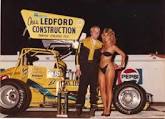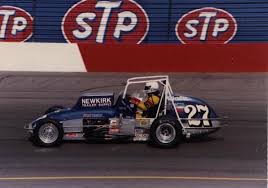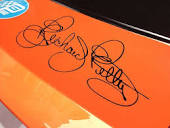Greetings from Avondale, Arizona
From the travels and adventures of the “World’s #1 Trackchaser”
Phoenix International Raceway – Oval – Lifetime track #49
Phoenix International Raceway – Road Course – Lifetime track #50
*
I have a long history with the Phoenix International Raceway.
I didn’t begin writing my famous Trackchaser Reports until I had seen about 430 tracks. My earliest visits to the Phoenix International Raceway (P.I.R.) were much earlier than that. I first began listing the dates I actually visited a racetrack in 1980. There were 71 tracks that I had visited prior to 1980. The asphalt oval at P.I.R. is officially listed as my 49th lifetime track. The P.I.R. road course is #50.
Carol and I lived in Phoenix from mid-1973 until mid-1974. As a matter of fact our oldest son, J.J. was born in Phoenix. My first remembrance of getting out to P.I.R. was for an IndyCar event. Back then they had an old main straightaway grandstand that was both rural and steep. I don’t know how many times I went to P.I.R. before 1980. I do know I’ve been there 11 times since 1980. For years I would go to the Copper World Classic usually held in February.
I was never a big fan of the track. Why? There were two reasons. First the setting sun was always in our eyes. It was especially bad for fans and drivers when it finished setting over turn #1. Additionally, I didn’t think there was enough passing at the track.
During all of my race watching I have seen seven fatalities occur. One was a fan being struck by Shane Carson as he walked across the track at the Baylands Raceway in Northern California. I saw two racing deaths at P.I.R.
In 1985, during the Copper World Classic, Florida racer Jim Haynes died in a most spectacular accident. He was driving a sprint car on the 1-mile asphalt oval. Haynes crashed into the second turn wall. The impact appeared to knock the driver unconscious while at the same time having the throttle stick on the race car. The disabled racer continued down the backstretch into turn three. The car, with its engine running wide open, hugged the wall around turns three and four. Then with Jim Haynes slumped over the steering wheel in the open cockpit car for all to see the car raced down the front straight. At full speed the car impacted the turn one wall and burst into flames. There is actually a YouTube video of this horrific accident. Sadly Jim Haynes passed away from his head injuries a few days later.
In 1991 I was witness to the crash of Danny Milburn at P.I.R. This crash resulted in a fatality. Danny was driving a USAC Silver Crown car during the Copper World Classic. His fatal crash was into the turn one wall at nearly full speed. I don’t think open-wheeled cars of this type have much chance with impacts like what Danny Milburn experienced. YouTube has a video of this accident as well.
On a much more positive note I had the pleasure of watching one of my favorites race at P.I.R., Richard Petty. I was there to see him win a NASCAR Winston West event at the track. The date was November 26, 1978. This was the first of his three Winston West wins at P.I.R. I hung out in the pits behind the old announcing tower after the race. It must have been well over an hour after the race had finished. Here came Richard Petty. I asked him to sign my program and he did so with his famous and most artistic autograph. I was a Richard Petty fan before that moment, during that moment and to this day.
Here’s what Wikipedia has to say about the Phoenix International Raceway:
Phoenix International Raceway, also known as PIR, is a one-mile, low-banked tri-oval race track located in Avondale, Arizona. The motorsport track opened in 1964 and currently hosts two NASCAR race weekends annually. PIR has also hosted the IndyCar Series, CART, USAC and the Rolex Sports Car Series. The raceway is currently owned and operated by International Speedway Corporation.
The raceway was originally constructed with a 2.5 miles (4.0 km) road course that ran both inside and outside of the main tri-oval. In 1991 the track was reconfigured with the current 1.51 miles (2.43 km) interior layout. PIR has an estimated grandstand seating capacity of around 67,000. Lights were installed around the track in 2004 following the addition of a second annual NASCAR race weekend.
Phoenix International Raceway is home to two annual NASCAR race weekends, one of 13 facilities on the NASCAR schedule to host more than one race weekend a year. The track is both the first and last stop in the western United States, as well as the second and second-to-last track on the schedule.
History
Construction of Phoenix International Raceway was completed in 1964. The track is built around the Estrella Mountains outside of Avondale, AZ. Because of the terrain and the incorporation of a road course and drag strip, designers had to build a “dogleg” into the backstretch. The original roadcourse was 2 miles (3.2 km) in length and ran both inside and outside of the main oval track. The hillsides adjacent to the track also offer a unique vantage point to watch races from. “Monument Hill”, located alongside turns 3 and 4, is a favorite among race fans because of the unique view and lower ticket prices. At the top of this hill lies a USGS bench marker known as Gila and Salt River Meridian, now listed on the National Register of Historic Places. Long before PIR existed, this spot was the original land survey point for all of what later became the state of Arizona
PIR in 1989
PIR was built with the goal of being the western home of open wheel racing. Sports cars and USAC began racing at the track in 1964, and the track quickly became a favorite of drivers and soon replaced the old track at the Arizona State Fairgrounds. In 1977, the first Copper World Classic was held, a marque event for USAC midget and Silver Crown cars.
NASCAR began racing at PIR in 1978, however, it wasn’t until 1988 when NASCAR’s premier series, now the Sprint Cup Series, began racing at the track. Following the announcement of NASCAR being added to the track schedule, PIR built a 3-story suite building outside of turn 1 and increased grandstand capacity to 30,000. A year prior, the track’s main grandstand was struck by lightning and burned to the ground, reconstruction was finished in time for the first NASCAR cup race. That first race was won by Alan Kulwicki where in his celebration he performed the first “Polish Victory lap.
In 1991, the old 2.5 miles (4.0 km) road course was removed and replaced by a 1.51 miles (2.43 km) infield road course. On August 25, 1992 the Guns N’ Roses/Metallica Stadium Tour came to the raceway. In 1996 the grandstand capacity was increased to 65,000. ISC officially took ownership of PIR from Emmett “Buddy” Jobe in April 1997. Racing at PIR began to dramatically change in 2003. The track reconstructed turn 2 by pushing back the outside wall to make racing safer. The wall originally came to an end where the old road course crossed the oval track. At the same time, an access tunnel was built under turn 4. Previously, vehicles had to use crossover gates and pedestrians used a crossover bridge. In 2004, NASCAR announced it would give a second annual race weekend to PIR starting with the 2005 season. Following the announcement, the track installed lights to allow the newly scheduled NASCAR race to be run in the evening. The addition of a second NASCAR racing weekend had dramatic effects on the economy of the state of Arizona. A study at the Arizona State University estimated that PIR brings in nearly $473 million annually to the state of Arizona. 2005 would also become the last year that a major open-wheel racing series would race at PIR. The track is still used by the IndyCar Series for testing purposes.
In 2006, the Allison Grandstand was expanded from turn 1 to turn 2, increasing the reserved seating to 76,800. Included with the expansion is “Octane”, an exclusive lounge on top of the grandstands overlooking turn 1. In 2008 PIR added the SPEED Cantina, a one-of-a-kind at-track sports bar and grill, outside turn 2. In early 2010, some of the grandstands along the backstretch were removed to allow additional room for recreational vehicles, thus the seating capacity dropped to around 67,000.
In November 2010, ISC and the Avondale City Council announced plans for a $100 million long-term development for PIR. $15 million would go towards repaving the track (first time since 1990) and building a new media center. The plans also include a reconfiguration of the track. The reconfiguration of the track made the width of the front stretch 62 feet (19 m), changed the pit stalls from asphalt to concrete, moved the dogleg (back stretch) outward by 95 feet (29 m), as well as making the radius of the dogleg 500 feet (150 m). Along with the other changes, the track changed to progressive banking with the banking of the first and second turn as well as the dogleg changing to 10–11 degrees, while the third and fourth turns will change to 8–9 degrees. The infield road course was also sealed off and removed from use, making PIR an oval-only facility. $7–8 million will go towards connecting the track property to the Avondale water and sewer systems. Work began following the 2011 Subway Fresh Fit 500. The reconfiguration project was completed by mid-August 2011, and on August 29–30, five drivers tested the new track, describing the new dogleg and backstretch as a “rollercoaster” as now when they enter it dips, then rises on exit and dips down going into turn 3, due to the elevation changes. On October 4–5, several Sprint Cup teams tested the oval which was open to the public.
Do you have any experience with auto racing at the Phoenix International Raceway?
You might have remembrances about this track. If so, please feel free to share them in the comments section below. If you have any photos from back in the day, send them to me at Ranlay@yahoo.com. I’ll try to include them here.








